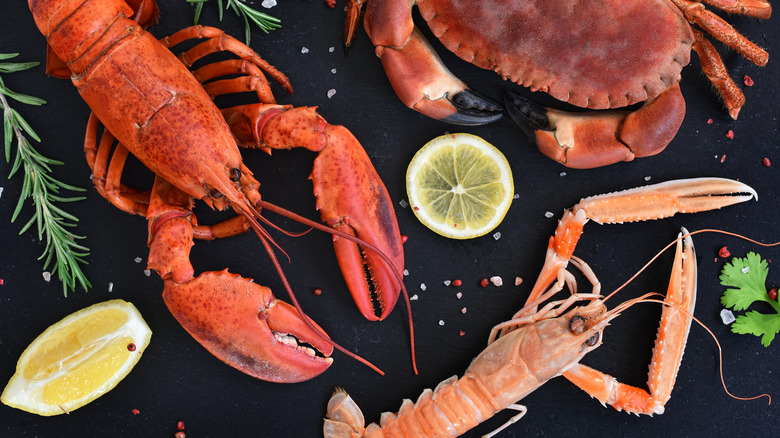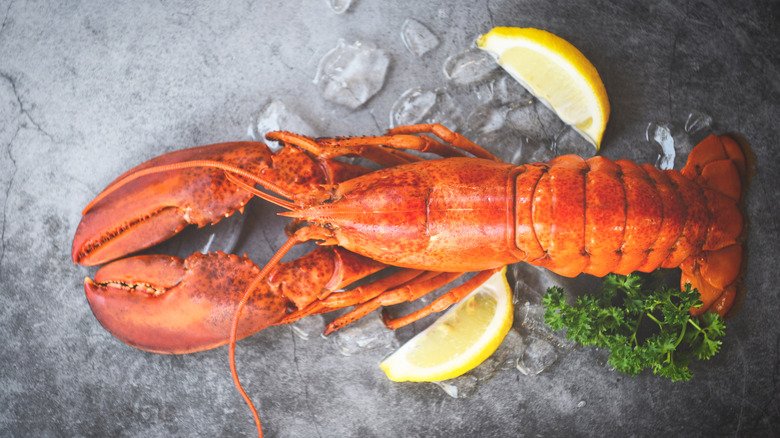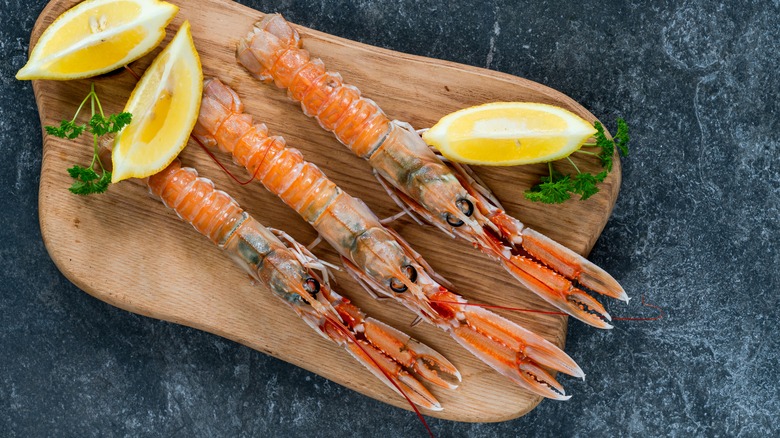Langoustine Vs. Lobster: What's The Difference?
Lobster stands alongside filet mignon and caviar as the ultimate mark of culinary luxury. Unsurprisingly, it comes at a high cost — so much so that $12 per pound is a veritable bargain, according to a 2022 CBS News report. Strangely enough, history shows that this wasn't always the case: For a long time, lobsters were long considered food for the poor, eaten by servants and prisoners. As noted by the Pacific Standard, this goes back to the early days of colonial America, when lobsters were so abundant in the waters of New England that they washed ashore in heaps. As it turns out, the main reason people frowned upon lobster is that they only cooked them after they'd been dead for some time. Once folks started eating them fresh, they discovered how delicious lobsters can be. By the 20th century, lobster was being marketed as a luxury dish (and potential aphrodisiac) at some of the East Coast's finest restaurants.
Though this is a uniquely American story, but lobsters are not exclusive to the U.S. What we in the Western Hemisphere refer to as "lobster" is technically the American lobster, just one of many lobster species (via National Geographic). If you travel across the Atlantic, you'll discover a couple of other notable varieties. One is a lesser-known species worthy of our attention called langoustine — and while it bears only a cursory resemblance to the lobsters we're most familiar with, it offers a uniquely luxurious dining experience.
What are lobsters?
Let's compare and contrast lobsters and langoustines, starting with the most familiar of the two. As previously mentioned, the animal that Americans refer to as the "lobster" is actually the American lobster (also known by its scientific name Homarus americanus), a rather large species capable of growing as much as three feet in length (via National Geographic). They can be quite hefty as well — up to 44 pounds, according to the National Oceanic and Atmospheric Administration (NOAA). If someone asks you to picture a lobster, your mind's eye probably colors it red, but this hue is only achieved by cooking the creature. Live lobsters tend to have dark, greenish-brown shells, and if you go to your local fishmonger or check out your closest seafood restaurant's requisite lobster tank, you can see this for yourself.
The main edible parts of the lobster are its claws, tail, head, and body, with the claws and tail being the most popular among diners. According to Maine Lobster Now, the tail is the meatiest and easiest to handle, but the meat also tends to be chewy, as the tail muscles get a lot of use propelling the lobster around. The claws don't get used as much, so the meat within them is more tender. The head and body contain a good amount of meat, though it might be trickier extracting it from between the thin shell segments. Female lobsters sometimes contain edible roe (eggs) that are naturally black but also turn red in the cooking process.
What are langoustines?
Langoustines — also known as Norwegian lobsters, Dublin Bay prawns, or scampi (not to be confused with shrimp scampi) — inhabit the Northeast Atlantic, according to Trinity College Dublin. Langoustines look much different than American lobsters; topping out at about 10 inches lengthwise, the Food Network likens them to large crayfish. They have pale pink shells that, unlike lobsters, retain their color when cooked. Langoustines are highly prized in Europe (particularly in French and Spanish cuisine), though more than half the world's supply comes from Scotland. In order to protect the species, the British government and the European Union impose strict limits on how many can be sold each year. This is one of the main reasons langoustines cost even more than lobsters.
According to Bon Appétit, langoustines go for nearly $40 per pound in the U.S., due to the fact that Americans can only get them via imports. Langoustines begin to rot as soon as they die, so they must be kept alive on their transatlantic journey. Each langoustine must be shipped in a separate container because they cannot peacefully cohabitate. Given the expense, you might wonder why langoustines are worth eating in the first place. Many find langoustine meat superior to lobster, as it is much sweeter. Indeed, their reputation is of the highest caliber; in an article for the Food Network, author and food writer Simon Majumdar stated that "[langoustines] would probably rank in my top 10 food experiences in the world." If fortune smiles upon your wallet, maybe you can say the same.


